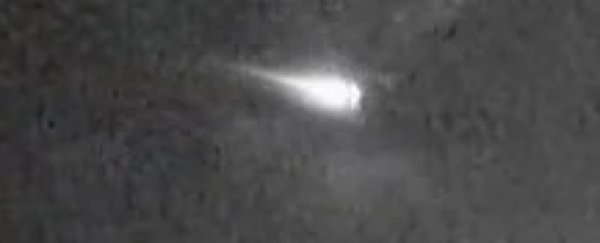On Wednesday night, around 100 kilometres (60 miles) south of Australia's Tasmanian coast, those on board the research vessel Investigator witnessed something amazing.
At 9:21 pm local time, a bright green meteor streaked across the sky before breaking up over the Tasman Sea – disappearing from view in just a few short seconds. If anything made it through the atmosphere, it was likely soon to be at the bottom of the ocean - a fleeting, final burst of light, before disappearing forever.
But fortunately for us, this incredible event wasn't only seen by human eyes.
The RV Investigator has a 24/7 livestream, and with a stroke of luck, the camera was in just the right position to capture the whole thing.

"The meteor crosses the sky directly in front of the ship and then breaks up – it was amazing to watch the footage and we were very fortunate that we captured it all on the ship livestream," says CSIRO Voyage Manager John Hooper.
"The size and brightness of the meteor was incredible."
With the footage of the incident being in black and white, we'll have to take the researchers' word for it about the meteor appearing green, but a green meteor is not as uncommon as you might think.
In fact, earlier this year we wrote about another green meteor gracing the skies across Australia – that one being on the other side of the country in northern Western Australia.
"A lot of our fireballs will turn green and then kind of turn more orangey as they get deeper," Eleanor Sansom, the project manager of the Desert Fireball Network told ScienceAlert at the time.
While the colour doesn't tell us much about the meteorite itself, the intense brightness of the fireball is a sign of the object's size and speed.
"Over 100 tonnes of natural space debris enters Earth's atmosphere every day," CSIRO Astronomer Glen Nagle explained.
"Most of it goes unseen as it occurs over an unpopulated area like the Southern Ocean."
Although the volume of incoming space debris sounds quite terrifying, small meteors are unlikely to cause problems for us on the surface. NASA has a list of large asteroids it keeps track of, but most small meteors burn up in the atmosphere and leave little trace, just as this one appears to do.
With all those tonnes of space debris, you would think that fantastic meteors would be a regular sight. In this case, although there were a number of reports in Hobart of those who saw the meteor, so far there doesn't seem to be any other footage.
"Cameras are everywhere, in our pockets and around our cities, but they have to be pointed in the right place at the right time – RV Investigator was in that place and time," Nagle said.
